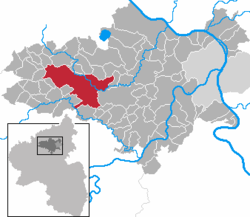Mayen
| Mayen | ||
|---|---|---|

Old city hall
|
||
|
||
| Coordinates: 50°20′0″N 7°13′0″E / 50.33333°N 7.21667°ECoordinates: 50°20′0″N 7°13′0″E / 50.33333°N 7.21667°E | ||
| Country | Germany | |
| State | Rhineland-Palatinate | |
| District | Mayen-Koblenz | |
| Government | ||
| • Lord Mayor | Wolfgang Treis (Greens) | |
| Area | ||
| • Total | 58.04 km2 (22.41 sq mi) | |
| Elevation | 230 m (750 ft) | |
| Population (2015-12-31) | ||
| • Total | 18,818 | |
| • Density | 320/km2 (840/sq mi) | |
| Time zone | CET/CEST (UTC+1/+2) | |
| Postal codes | 56727 | |
| Dialling codes | 02651 | |
| Vehicle registration | MYK, MY | |
| Website | www.mayen.de | |
Mayen is a town in the Mayen-Koblenz District of the Rhineland-Palatinate Federal State of Germany, in the eastern part of the Volcanic Eifel Region. As well as the main town, additional settlements include Alzheim, Kürrenberg, Hausen-Betzing, Hausen and Nitztal. Mayen is the administrative centre of the Vordereifel ‘Collective Municipality’, although it is not part of the municipality.
To the west, as well as to the north and south-west of Mayen, is the country landscape of the Eifel. To the east, the landscape flattens out, running towards the Koblenz-Neuwied Basin, which is divided into the northern section of Pellenz and the southern section of Maifeld. This area is geographically considered to be part of the Eifel. Mayen is often called ‘The Gateway to the Eifel’.
The small river Nette runs through the town, flowing from the Eifel towards Weißenthurm on the Rhine.
Even in Roman times, Mayen (Lat. Megina) was an important economic centre. From the end of the 3rd century up until the Middle Ages, potteries operated here, and their products were traded and sold across Central Europe. During prehistoric times, nearby quarries were the sources of basalt to make millstones and tuff used to make sarcophagi. These sarcophagi were found buried with significant glass artifacts as grave goods. (Both classes of items are displayed in the Genovevaburg Museum in Mayen).
The name Mayen probably comes from the name Megina. Records from as far back as 847 show this as a designation of the town; it was adapted by the Romans from the Celtic word magos, meaning field. In the 8th century the legend of Genoveva of Brabant, names Mayen as the seat of government of Duke Siegfried of the Pfalz.
Mayen received its first official recognition in 1041, and was granted Town Status in 1291 from Rudolf I von Habsburg, at the same time as Bernkastel, Welschbillig, Montabaur and Saarburg. Mayen is possibly linked to the town of Maifeld, which lies a short distant to the south-east, since Mayen was called the capital of the Meiengau in the Middle Ages.
...
Wikipedia



